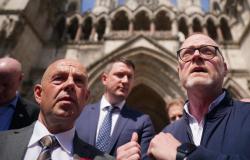It may sound counter-intuitive, but Donald Trump has probably done more to strengthen Nato than any other political leader in recent years. While he was president, he berated European members of the alliance for failing to pay what he called their “dues,” accusing them of freeloading on the US.
Earlier this year, he seemed to go even further by suggesting at an election rally, not only that he would not bring America to the defense of “delinquent” Nato members, but would encourage Russia to attack them. Cue a predictable international outcry, led by Nato secretary-general Jens Stoltenberg, who accused him of undermining “all of our security.” Joe Biden, of course, waded in, saying Trump’s remarks were “appalling and dangerous” and would give Putin “a green light for more war and violence.”
Both of them were wrong. Anyone who has the slightest understanding of Trump’s negotiating techniques knows that he is unlikely to have meant what he said literally; it was a rhetorical device to emphasize his entirely valid point about recalcitrant Nato members. As for a green light, it was Biden who flashed that at Putin with his disastrous retreat from Kabul in 2021, which can only have contributed to Moscow’s calculations on invading Ukraine the following year.
Trump’s presidency was in fact a red light against Putin’s aggression, largely because of his unpredictable nature. And that same unpredictability has now rattled many Nato leaders into recognizing that they need to step up their defense efforts for fear that he might abandon Nato in a second term.
Poland, now with the largest defense spending by percentage of GDP in the whole of the alliance, has bolstered its military out of fear of Russian invasion. But do we really think that the likes of Germany would finally have started to get their act together without genuine concern over a second Trump presidency? It doesn’t seem to have been Putin’s invasion that spurred them into action. We’ve had two years of heel-dragging and inadequate military support to Kyiv on the part of France and Germany. Britain, meanwhile, has been inexplicably continuing to reduce the size of its Armed Forces.
But not any longer. And Rishi Sunak even implicitly linked his announcement of a significant boost in defense spending to Trump, when he said: “We can’t keep thinking America will pay any price or bear any burden if we are unwilling to make sacrifices for our own security” . Sunak’s long overdue uplift was not only intended to bring Britain’s defenses closer to where they need to be, but also to encourage other Nato members to match our future spending of 2.5 per cent of GDP in anticipation of a potential Trump victory in November.
UK ministers are reportedly actively pushing for that ahead of the Nato summit in Washington this summer. Even 2.5 per cent will not be enough to meet Nato’s new capability targets, but at least it is a start. Eighteen Nato members will meet the current 2 per cent target this year, a significant rise compared to the start of Trump’s first presidency.
Remembering Trump’s mercurial character, it is of course possible that as president he might actually pull the US out of Nato, although that would require Congressional approval. His then National Security Adviser, John Bolton, said he came close to doing so back in 2018. But even if that happens, Trump-driven increased spending in Europe will have already made the world a safer place. Combined with greater military capability, the political will demonstrated by making hard choices on defense expenditure in a tough economic climate will act as the most effective deterrent against aggression.






